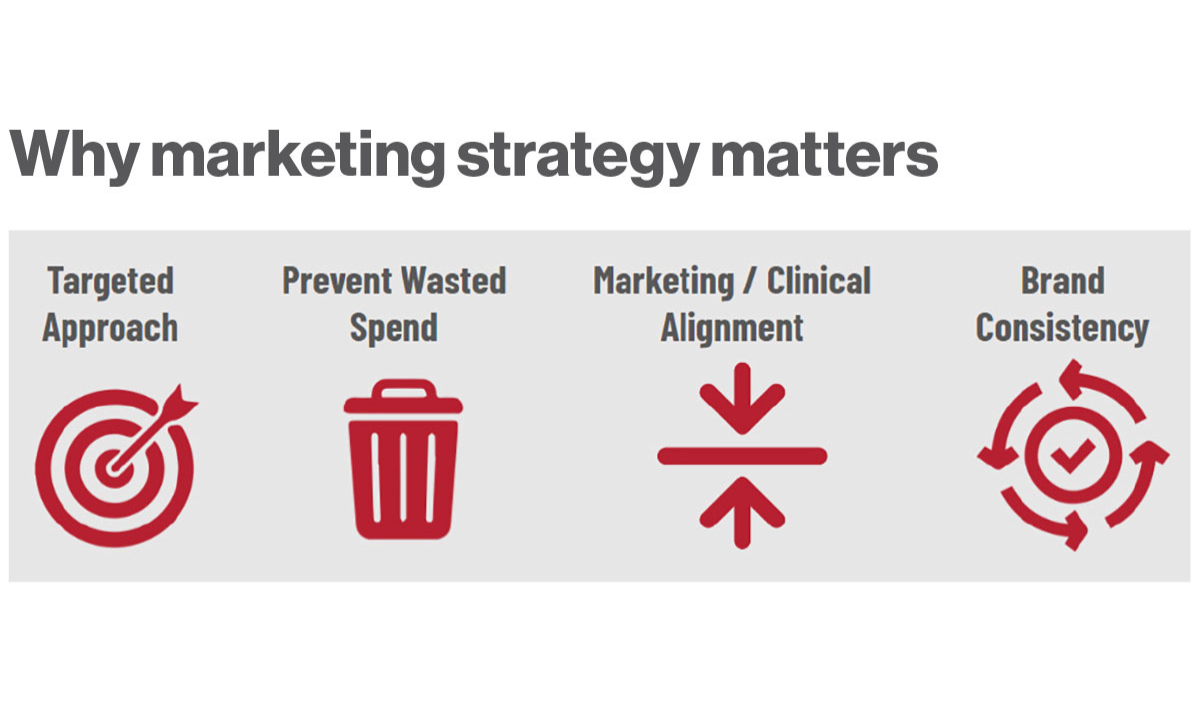How a system for new patient acquisition could boost your bottom line.
In dental organizations, growing revenue and expanding locations depends on a company’s bottom line. Once you have covered overhead costs (such as doctors’ salaries and supply costs), then each new patient that a practice gets to come inside their door falls within the bottom line. For this reason, dental organizations should always be focused on driving new patients.
The following are actionable steps to market to new patients now and prep for the future of your practice’s patient acquisition.
Revenue and marketing
One way a company can increase its revenue and new patient acquisition is through its marketing campaigns. Margins today in dental are getting tighter by the minute, and dental companies must adapt to this by being more efficient with their marketing budgets. Efficiency in marketing budgets includes changing both a company’s messaging and campaign strategies to better target the ideal patient or “avatar,” which is specific to the practice’s clinical capabilities.
All dental organizations are in the marketing business, and therefore must consider marketing goals. Sometimes, a practice may address advertising responsibilities by hiring a marketing vendor. If your organization doesn’t have a vendor or is struggling to know if their vendor is right, DEO has a vendor checklist that organizations can review before making either a change or decision.
Creating marketing campaigns and enticing new patients starts with an understanding of the foundations of successful marketing. DEO’s Foundations of Marketing include an understanding of an organization’s ideal customer, having a goal for new patients that is tied to the revenue and profitability for each practice every month, establishing a marketing budget, and understanding KPIs that need to be in place to demonstrate that a company is ready for marketing expenditures (operational KPIs include knowing a practice’s target patient, knowing call conversion and answer rates, and knowing how patients are getting scheduled including recall rescheduling and treatment coordination).
The Four Ms
It is important to first consider strategy when deciding on a marketing plan. Once a marketing plan has been agreed on amongst the leaders of a company, it is time to create campaigns that appeal to potential new patients. When creating a new campaign, follow the Four Ms of marketing:
1. Market
2. Messaging
3. Measure
4. Medium
The first “M”, market, determines the ideal audience that a dental organization is trying to attract. Many dental businesses often say that they are a “bread and butter” dental company, referring to the fact that they advertise to all types of patients and ages, and that they will take anyone in no matter the case. It is more likely, however, that the practice has a type of patient they can best assist with their skillset, or that they may prefer treating. This preferred type of patient, also known as an “avatar,” is a method for defining and segmenting patient demographics, needs, and preferences. The avatar is the type of patient that a practice specializes in seeing.
Define your practice’s avatar by asking what patients the company is seeing now, and which patients the team would duplicate if they could. Make sure that the patient demographic chosen matches the clinical capabilities and services of the organization. Consider what insurance an ideal patient is on, where they live, and if the patients are from rural, suburban, or urban communities.
| RISE Dental Practices and keywords RISE Dental Practices’ avatar is patients aged 25-55, with an income of $70,000 and higher, and within a 10-mile radius of the office. To appeal to them, Katie Vollmer, Marketing Director of RISE Dental Practices, said the company uses keywords such as “same-day” and “emergency” dentistry. RISE Dental Practices’ call to action is “click to schedule,” “same-day services,” “dental implants,” “crowns,” “latest in dental technology,” and more. Vollmer’s company outsources marketing responsibilities, and the digital marketing company supports her organization by using paid Google search and display ads. The digital marketing company also does A/B testing to measure the organization’s marketing outcomes, so they can better understand if certain campaigns are working. For this case study, Vollmer modified the practice’s avatar to include another, new neighborhood within a 10-mile radius. For RISE Dental Practices, marketing spend in this specific case study did not increase, however Vollmer did notice that the company was still seeing an increase of 30 new patients per month. Then, they measured the following month and they again saw 30 new patients. Also, 90 percent of the organization’s website traffic was new traffic (people who had not been to the website before), simply by implementing the call to action or “click to call” messaging in advertisements. Vollmer recommends measuring who is clicking on each ad and then comparing it to which patients are converting to the schedule. In this case, RISE Dental Practices found success by testing their patient radius, maintaining the same patient avatar, and converting new customers by moving the milage radius. |
It is critical to understand your avatar so that marketing messaging is clearly defined. For example, if a customer does not know the avatar, they might seek emergency services or be an adult walking into a pediatric dental practice. For this reason, it is important for marketing leaders to have a clear understanding of your avatar to properly target new patients. An organization’s avatar also determines the medium and messaging that they will use. When you decide on a specific avatar, it allows the whole team to understand and cater to who is coming through the practice’s door.
Once an avatar is clearly defined and understood, the second “M,” messaging, should be tailored toward these specific clients. In advertisements, highlight problems your avatar might be facing and solutions your company offers. Then, clearly define what you want a potential customer to do with an action statement, such as “click here to call,” “book now,” “watch this video,” or “fill out this form.” Craft compelling and enticing messages to attract potential patients.
Once a practice is clear on their message, it is time to work through the third “M” of marketing, the medium, also known as the “channels” you’ll deliver the message on. Identify where the organization is planning to deliver the message. This can include social media, digital, on the website, paid ads, flyers, banners, billboards, direct mail, community events, and more. It is important when creating a marketing campaign to be clear about who the practice serves and use that to decide where exactly to deliver that message and how. As an example, if you are building a de novo practice, getting out into the community is important. If your practice has an older demographic, print and media marketing are very valuable. It often takes 7 to 10 touches to convert an individual to becoming a patient. The more a practice diversifies its marketing channel, the better, as it helps people connect with your business and get those touchpoints faster.
| MI Smiles Dental Group’s referral program MI Smiles Dental Group tackled a cheap, effective marketing strategy for patient referrals. Referred patients are often more loyal and trusting when it comes to new patient acquisition tactics, so the practice created a referral program to systematically encourage staff and patients to refer their friends and family, said Laura Rogers, Director of Marketing & Finance at MI Smiles Dental Group. The referral program works by giving away a prize for the most amount of patient referrals. This takes place about every three months, with prize options including TVs, grills, kayaks, iPads, gaming systems, and more. The medium for MI Smiles Dental Group’s campaign is printed referral cards, as well as direct-to-patient emails and signage in the office. The call to action on the card is “refer your friends and family.” In their office, for every qualified referral card that comes back in, the team member that gave that card out gets a $20 gift card of their choosing. So overall, this tactic results in lower acquisition costs for patients. It also keeps team members engaged, and it gives them a way to earn a little bit extra money for fun things. |
The fourth “M”, measure, is a critical step so that an organization can understand its progress. Simplify the process of measuring marketing progress by asking: did our patient numbers go up, and if so, by how much? Measure this number before beginning a new marketing campaign, and after. Ask what the goal of the campaign was, and what the budget was. Track, measure, and monitor any measurable outcomes, and use these numbers to understand the organization’s baseline and to determine where to divert budget dollars.
Once you have a thorough understanding of the Four Ms of marketing, begin implementing your own marketing campaigns tailored to your organization’s avatar. This includes working with office managers to define each practice’s patient avatar, partnering with a marketing vendor to identify appropriate messaging and medium, deciding a marketing lead/vendor, and measuring reviews or results of the campaign. Through these steps, dental practices can be on their way to increase revenue through new patient acquisition.
| Dentistes REMA and community events Dentistes REMA used community events to increase the number of new patients. Valerie Leblanc, Marketing Director of Dentistes REMA, said she and her team participated in an Invisalign community event campaign at their practice with four exam rooms open for three hours with four hygienists, one doctor, and two treatment coordinators for an evening. Each qualified lead went through specific steps with the potential patients including describing what Invisalign is, showing patients visuals such as pictures and X-Rays, and providing a comprehensive oral scan for each patient. At the event, the patients also got to see their smile simulation and meet with treatment coordinators to discuss treatment financial plans. To give a sense of urgency, Leblanc and her team placed a rebate on the deal that was valid for two weeks only. The ideal market was determined to be both regular patients and prospective patients. Women aged 25-45 years old and adults 18 plus within a 10-mile radius were targeted on Facebook and with flyers placed in the office. The advertisement’s message let patients know that the Invisalign event was taking place, provided a link to register for the event, and let them know that the free consultation had a value of $195. Dentistes REMA’s call to action was to “book now,” which led anyone interested to an online signup form. To measure campaign stats, the organization used a shared Excel spreadsheet with basic data and campaign results. In total, 38 forms were filled out, and the practice kept 12 qualified patient leads. The practice spent $2,000 on Facebook ads and $50 on posters and received a 1/10 return on investment with two new patients valued at $1,500. Leblanc says to keep in mind that these procedures can be a lot of money that patients are spending, and that they may be very interested in treatment, but may wait until they can afford the service. The more money a patient is going to spend, often the longer it takes for them to convert. Don’t necessarily give up on an ad if it’s only been a few weeks. Nurture campaigns once you’ve gotten a first lead. |





